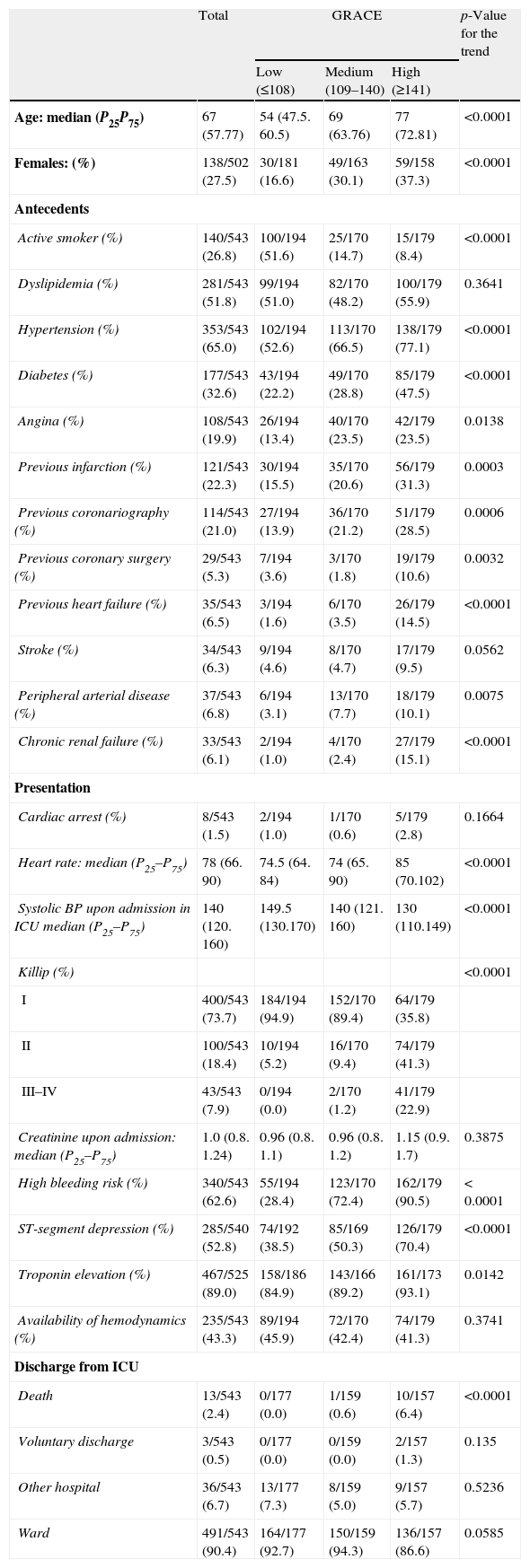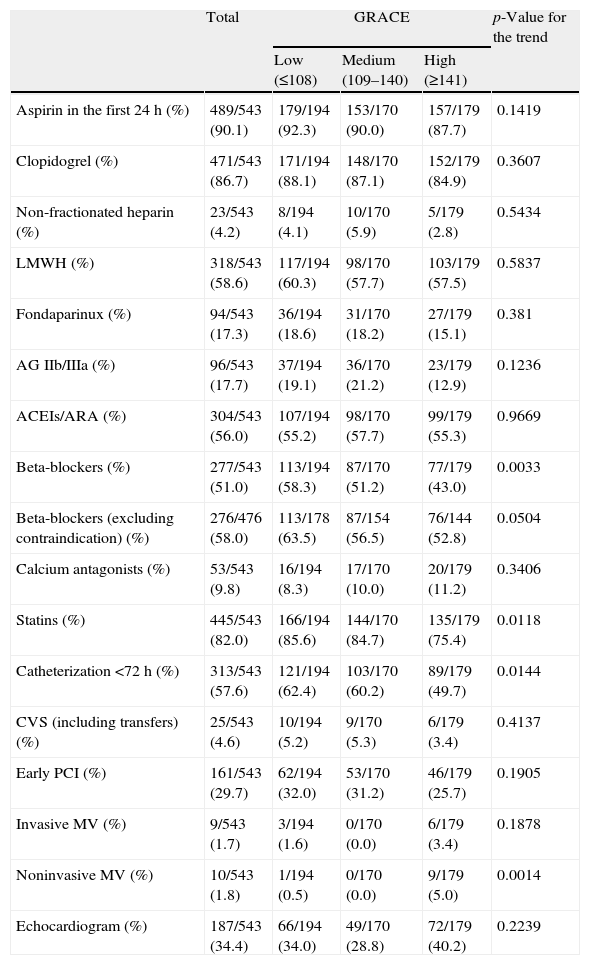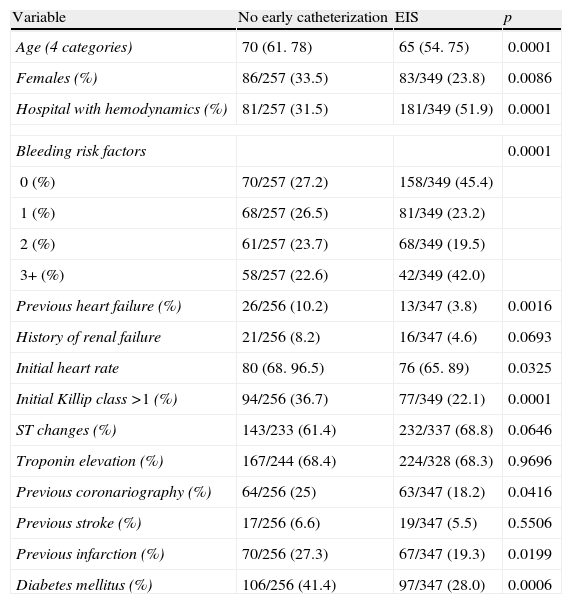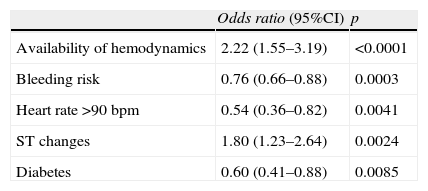Observational studies have reported a paradoxical inverse relationship between the use of an early invasive strategy (EIS) and the risk of events in patients with non-ST-segment elevation acute coronary syndrome (NSTE ACS). The study objectives are: (1) to examine the association between baseline risk in patients with NSTE ACS and the use of EIS; and (2) to identify some of the factors independently associated to the use of EIS.
DesignRetrospective cohort study.
SettingIntensive care units participating in the SEMICYUC ARIAM Registry.
PatientsConsecutive patients admitted with a diagnosis of NSTE-ACS within 48h of evolution between the months of April and July 2010.
InterventionsNone.
Main outcomesCoronary angiography with or without angioplasty within 72h, risk stratification using the GRACE scale.
ResultsWe analyzed 543 patients with NSTE-ACS, of which 194 were of low risk, 170 intermediate risk and 179 high risk. The EIS was used in 62.4% of the patients at low risk, in 60.2% of those with intermediate risk, and in 49.7% of those at high risk (p for tendency 0.0144). The EIS was used preferentially in patients with low severity and comorbidity. In the logistic regression model, EIS was independently associated to the availability of a catheterization laboratory (OR 2.22 [95%CI 1.55–3.19]), the presence of ST changes on ECG (OR 1.80 [1.23–2.64]), or the existence of a low risk of bleeding (OR 0.76 [0.66–0.88)]. Conversely, EIS was less prevalent in patients with diabetes (OR 0.60 [0.41–0.88]) or tachycardia upon admission (OR 0.54 [0 36–0.82]).
ConclusionsIn 2010 there remained a lesser relative use of EIS in patients at high risk, due in part to an increased risk of bleeding in these patients.
Algunos estudios observacionales han comunicado una paradójica menor utilización de la estrategia invasiva precoz (EIP) en los pacientes con síndrome coronario agudo sin elevación de ST (SCASEST) de alto riesgo. Los objetivos del estudio son: (1) Examinar la asociación entre el riesgo basal de los pacientes con SCASEST y el uso de una estrategia invasiva precoz (EIP) en la práctica clínica actual; (2) identificar algunos de los factores asociados de forma independiente con el uso de EIP.
DiseñoEstudio de cohortes retrospectivo
ÁmbitoUnidades de cuidados intensivos participantes en el registro ARIAM-SEMICYUC.
PacientesPacientes consecutivos ingresados con diagnóstico de SCASEST de menos de 48 horas de evolución entre los meses de abril-julio de 2010.
IntervencionesNinguna.
Variables principalesRealización de coronariografía con o sin angioplastia en las primeras 72 horas, estratificación del riesgo mediante la escala GRACE.
ResultadosSe analizaron 543 pacientes con SCASEST, de los cuales 194 eran de bajo riesgo, 170 de riesgo intermedio y 179 de riesgo alto. La EIP se utilizó en el 62,4% de los pacientes de bajo riesgo, el 60,2% de los de riesgo intermedio y el 49,7% de los de riesgo alto (p para la tendencia 0,0144). La EIP se utilizó de forma preferente en pacientes con baja gravedad y comorbilidad. En el modelo de regresión logística, la EIP se asoció de forma directa con la disponibilidad de laboratorio de hemodinámica (OR 2,22, [intervalo de confianza al 95% 1,55 a 3,19], la presencia de cambios de ST en el ECG (OR 1,80 [1,23 a 2,64]) y la existencia de un bajo riesgo hemorrágico (OR 0,76 [0,66 a 0,88]). Por el contrario, la EIP se asoció de forma negativa con la presencia de diabetes (OR 0,60 [0,41 a 0,88]) o de taquicardia al ingreso (OR 0,54 [0,36 a 0,82]).
ConclusionesEn el año 2010, persiste una menor utilización relativa de la EIP en los pacientes de alto riesgo, debido en parte al mayor riesgo hemorrágico de estos pacientes.
Based on the existing scientific evidence, the main clinical practice guides recommend an early invasive strategy (EIS) in patients with medium-high risk non-ST-segment elevation acute coronary syndrome (NSTE ACS).1–5 However, some registry-based studies have documented a paradoxically lesser utilization of early invasive strategies in high risk patients.6–12 The ARIAM-SEMICYUC study offers an opportunity to re-examine this problem based on the recent Spanish data.
The objectives of the present study are: (1) to describe the use of EIS in relation to the baseline risk of patients with NSTE ACS admitted to intensive care units (ICUs); and (2) to identify the independent predictors of the application of EIS in patients admitted due to NSTE ACS.
MethodsPatientsThe ARIAM-SEMICYUC project is a voluntary registry of patients with acute coronary syndrome (ACS) admitted to ICUs in Spain and Andorra. At present, trimestrial surveying is made, including all the consecutive patients admitted during the time period.
The present study includes the patients admitted with a diagnosis of NSTE ACS with an evolution of at least 48h from symptoms onset, and covering the period between 1 April and 15 July 2010.
During this period, a total of 43 hospitals participated in the survey (see Annex 1), with the inclusion of 1379 patients, of which 665 were admitted with a diagnosis of NSTE ACS. The GRACE score13,14 was available in 570 of these patients.
VariablesThe primary outcome variable of the study was cardiac catheterization (with or without intervention) in the first 72h after admission.
The patients were stratified according to the risk of suffering major cardiac events, based on the GRACE risk score upon admission, using the cutoff points (low, medium and high risk) pre-established in the literature.11,14
In addition to the risk level, a retrospective analysis was made of different variables available in the registry, such as the baseline clinical–demographic parameters, patient treatment and evolution, and possible catheterization predictors previously described in the literature. Bleeding risk was quantified by means of an ad hoc index based on the number of independent predictors of major bleeding contemplated by the GRACE,15,16 categorized as high or low risk according to the presence of some or no risk factor.
Statistical analysisThe descriptive analysis comprised the calculation of proportions (in the case of categorical variables) and medians, with the corresponding interquartile range (in the case of continuous variables).
The contrasting of hypotheses referred to proportions was carried out using the χ2 test (or the χ2 test for trends). In the case of quantitative variables, contrasting was based on the Mann–Whitney U-test (comparisons between 2 groups), the Kruskal–Wallis test (3 or more groups) or the Cuzick test (trends in 3 or more groups). All contrasts were two-sided, with an alpha level of significance of 5%.
With the purpose of identifying independent predictors of early catheterization, the variables found in the univariate analysis to be associated to the adoption of EIS with p<0.10 were entered in a multiple logistic regression model, adopting a backwards stepwise analytical strategy in which the least significant variable was eliminated in each step. Finally, the association between each of the predictor variables and the implementation of EIS was evaluated by calculating the adjusted odds ratios (ORs) and their corresponding 95% confidence intervals (CI).
ResultsThe profile of the patients, stratified according to GRACE risk level, was consistent with that of other registries8,9,11 (Table 1). The high risk group was characterized by older age, a greater proportion of women, increased comorbidity (diabetes, previous infarction, renal failure), the existence of heart failure upon admission, a high baseline bleeding risk, and increased mortality.
Profile of the patients with NSTE ACS according to baseline risk.
| Total | GRACE | p-Value for the trend | |||
| Low (≤108) | Medium (109–140) | High (≥141) | |||
| Age: median (P25P75) | 67 (57.77) | 54 (47.5. 60.5) | 69 (63.76) | 77 (72.81) | <0.0001 |
| Females: (%) | 138/502 (27.5) | 30/181 (16.6) | 49/163 (30.1) | 59/158 (37.3) | <0.0001 |
| Antecedents | |||||
| Active smoker (%) | 140/543 (26.8) | 100/194 (51.6) | 25/170 (14.7) | 15/179 (8.4) | <0.0001 |
| Dyslipidemia (%) | 281/543 (51.8) | 99/194 (51.0) | 82/170 (48.2) | 100/179 (55.9) | 0.3641 |
| Hypertension (%) | 353/543 (65.0) | 102/194 (52.6) | 113/170 (66.5) | 138/179 (77.1) | <0.0001 |
| Diabetes (%) | 177/543 (32.6) | 43/194 (22.2) | 49/170 (28.8) | 85/179 (47.5) | <0.0001 |
| Angina (%) | 108/543 (19.9) | 26/194 (13.4) | 40/170 (23.5) | 42/179 (23.5) | 0.0138 |
| Previous infarction (%) | 121/543 (22.3) | 30/194 (15.5) | 35/170 (20.6) | 56/179 (31.3) | 0.0003 |
| Previous coronariography (%) | 114/543 (21.0) | 27/194 (13.9) | 36/170 (21.2) | 51/179 (28.5) | 0.0006 |
| Previous coronary surgery (%) | 29/543 (5.3) | 7/194 (3.6) | 3/170 (1.8) | 19/179 (10.6) | 0.0032 |
| Previous heart failure (%) | 35/543 (6.5) | 3/194 (1.6) | 6/170 (3.5) | 26/179 (14.5) | <0.0001 |
| Stroke (%) | 34/543 (6.3) | 9/194 (4.6) | 8/170 (4.7) | 17/179 (9.5) | 0.0562 |
| Peripheral arterial disease (%) | 37/543 (6.8) | 6/194 (3.1) | 13/170 (7.7) | 18/179 (10.1) | 0.0075 |
| Chronic renal failure (%) | 33/543 (6.1) | 2/194 (1.0) | 4/170 (2.4) | 27/179 (15.1) | <0.0001 |
| Presentation | |||||
| Cardiac arrest (%) | 8/543 (1.5) | 2/194 (1.0) | 1/170 (0.6) | 5/179 (2.8) | 0.1664 |
| Heart rate: median (P25–P75) | 78 (66. 90) | 74.5 (64. 84) | 74 (65. 90) | 85 (70.102) | <0.0001 |
| Systolic BP upon admission in ICU median (P25–P75) | 140 (120. 160) | 149.5 (130.170) | 140 (121. 160) | 130 (110.149) | <0.0001 |
| Killip (%) | <0.0001 | ||||
| I | 400/543 (73.7) | 184/194 (94.9) | 152/170 (89.4) | 64/179 (35.8) | |
| II | 100/543 (18.4) | 10/194 (5.2) | 16/170 (9.4) | 74/179 (41.3) | |
| III–IV | 43/543 (7.9) | 0/194 (0.0) | 2/170 (1.2) | 41/179 (22.9) | |
| Creatinine upon admission: median (P25–P75) | 1.0 (0.8. 1.24) | 0.96 (0.8. 1.1) | 0.96 (0.8. 1.2) | 1.15 (0.9. 1.7) | 0.3875 |
| High bleeding risk (%) | 340/543 (62.6) | 55/194 (28.4) | 123/170 (72.4) | 162/179 (90.5) | < 0.0001 |
| ST-segment depression (%) | 285/540 (52.8) | 74/192 (38.5) | 85/169 (50.3) | 126/179 (70.4) | <0.0001 |
| Troponin elevation (%) | 467/525 (89.0) | 158/186 (84.9) | 143/166 (89.2) | 161/173 (93.1) | 0.0142 |
| Availability of hemodynamics (%) | 235/543 (43.3) | 89/194 (45.9) | 72/170 (42.4) | 74/179 (41.3) | 0.3741 |
| Discharge from ICU | |||||
| Death | 13/543 (2.4) | 0/177 (0.0) | 1/159 (0.6) | 10/157 (6.4) | <0.0001 |
| Voluntary discharge | 3/543 (0.5) | 0/177 (0.0) | 0/159 (0.0) | 2/157 (1.3) | 0.135 |
| Other hospital | 36/543 (6.7) | 13/177 (7.3) | 8/159 (5.0) | 9/157 (5.7) | 0.5236 |
| Ward | 491/543 (90.4) | 164/177 (92.7) | 150/159 (94.3) | 136/157 (86.6) | 0.0585 |
Regarding the drug treatment administered from symptoms onset and during admission to the ICU (Table 2), the patients at high risk were less often treated with statins and beta-blockers, with no other significant differences among the three risk levels. Likewise, risk level was directly correlated to the use of noninvasive mechanical ventilation, with a negative association to the adoption of EIS—though the differences failed to reach statistical significance.
Drug treatment and diagnostic–therapeutic procedures according to baseline risk during admission to the Intensive Care Unit.
| Total | GRACE | p-Value for the trend | |||
| Low (≤108) | Medium (109–140) | High (≥141) | |||
| Aspirin in the first 24h (%) | 489/543 (90.1) | 179/194 (92.3) | 153/170 (90.0) | 157/179 (87.7) | 0.1419 |
| Clopidogrel (%) | 471/543 (86.7) | 171/194 (88.1) | 148/170 (87.1) | 152/179 (84.9) | 0.3607 |
| Non-fractionated heparin (%) | 23/543 (4.2) | 8/194 (4.1) | 10/170 (5.9) | 5/179 (2.8) | 0.5434 |
| LMWH (%) | 318/543 (58.6) | 117/194 (60.3) | 98/170 (57.7) | 103/179 (57.5) | 0.5837 |
| Fondaparinux (%) | 94/543 (17.3) | 36/194 (18.6) | 31/170 (18.2) | 27/179 (15.1) | 0.381 |
| AG IIb/IIIa (%) | 96/543 (17.7) | 37/194 (19.1) | 36/170 (21.2) | 23/179 (12.9) | 0.1236 |
| ACEIs/ARA (%) | 304/543 (56.0) | 107/194 (55.2) | 98/170 (57.7) | 99/179 (55.3) | 0.9669 |
| Beta-blockers (%) | 277/543 (51.0) | 113/194 (58.3) | 87/170 (51.2) | 77/179 (43.0) | 0.0033 |
| Beta-blockers (excluding contraindication) (%) | 276/476 (58.0) | 113/178 (63.5) | 87/154 (56.5) | 76/144 (52.8) | 0.0504 |
| Calcium antagonists (%) | 53/543 (9.8) | 16/194 (8.3) | 17/170 (10.0) | 20/179 (11.2) | 0.3406 |
| Statins (%) | 445/543 (82.0) | 166/194 (85.6) | 144/170 (84.7) | 135/179 (75.4) | 0.0118 |
| Catheterization <72h (%) | 313/543 (57.6) | 121/194 (62.4) | 103/170 (60.2) | 89/179 (49.7) | 0.0144 |
| CVS (including transfers) (%) | 25/543 (4.6) | 10/194 (5.2) | 9/170 (5.3) | 6/179 (3.4) | 0.4137 |
| Early PCI (%) | 161/543 (29.7) | 62/194 (32.0) | 53/170 (31.2) | 46/179 (25.7) | 0.1905 |
| Invasive MV (%) | 9/543 (1.7) | 3/194 (1.6) | 0/170 (0.0) | 6/179 (3.4) | 0.1878 |
| Noninvasive MV (%) | 10/543 (1.8) | 1/194 (0.5) | 0/170 (0.0) | 9/179 (5.0) | 0.0014 |
| Echocardiogram (%) | 187/543 (34.4) | 66/194 (34.0) | 49/170 (28.8) | 72/179 (40.2) | 0.2239 |
AG IIb/IIIa: glycoprotein IIb/IIIa antagonists; CVS: cardiovascular surgery; LMWH: low molecular weight heparin; PCI: percutaneous coronary intervention; ACEIs/ARA: angiotensin converting enzyme inhibitors/aldosterone receptor antagonists; MV: mechanical ventilation.
The variables associated to the implementation of EIS are summarized in Table 3. Basically, the group of patients with NSTE ACS subjected to early invasive treatment were younger, with a lesser prevalence of diabetes and of heart failure upon admission, a lesser bleeding risk, and were admitted to a hospital with the availability of a hemodynamics laboratory.
Profile of the patients with/without catheterization in the first 72h (known predictors of catheterization in NSTE ACS).
| Variable | No early catheterization | EIS | p |
| Age (4 categories) | 70 (61. 78) | 65 (54. 75) | 0.0001 |
| Females (%) | 86/257 (33.5) | 83/349 (23.8) | 0.0086 |
| Hospital with hemodynamics (%) | 81/257 (31.5) | 181/349 (51.9) | 0.0001 |
| Bleeding risk factors | 0.0001 | ||
| 0 (%) | 70/257 (27.2) | 158/349 (45.4) | |
| 1 (%) | 68/257 (26.5) | 81/349 (23.2) | |
| 2 (%) | 61/257 (23.7) | 68/349 (19.5) | |
| 3+ (%) | 58/257 (22.6) | 42/349 (42.0) | |
| Previous heart failure (%) | 26/256 (10.2) | 13/347 (3.8) | 0.0016 |
| History of renal failure | 21/256 (8.2) | 16/347 (4.6) | 0.0693 |
| Initial heart rate | 80 (68. 96.5) | 76 (65. 89) | 0.0325 |
| Initial Killip class >1 (%) | 94/256 (36.7) | 77/349 (22.1) | 0.0001 |
| ST changes (%) | 143/233 (61.4) | 232/337 (68.8) | 0.0646 |
| Troponin elevation (%) | 167/244 (68.4) | 224/328 (68.3) | 0.9696 |
| Previous coronariography (%) | 64/256 (25) | 63/347 (18.2) | 0.0416 |
| Previous stroke (%) | 17/256 (6.6) | 19/347 (5.5) | 0.5506 |
| Previous infarction (%) | 70/256 (27.3) | 67/347 (19.3) | 0.0199 |
| Diabetes mellitus (%) | 106/256 (41.4) | 97/347 (28.0) | 0.0006 |
The logistic regression analysis (Table 4) identified the availability of a hemodynamics laboratory, the presence of ST-segment changes, the absence of diabetes, the absence of tachycardia upon admission, and the existence of low bleeding risk as independent predictors of the use of an invasive treatment strategy. Previous coronariography was not independently correlated to the adoption of EIS (adjusted OR 0.77, 95%CI 0.50–1.21), and did not act as an effect modifier of the association between the GRACE level and the implementation of EIS (interaction p-value=0.8425). On replacing heart rate with the Killip class, the presence of class >1 was found to be significantly associated to a lesser utilization of invasive strategies (OR 0.64, 95%CI 0.42–0.96).
DiscussionThe results of the present study confirm the inverse relationship between the risk of events and the use of an EIS in NSTE ACS, detected in previous studies.6,8–11,17,18 At first sight this is paradoxical, since it would indicate that the patients who could benefit most from such treatment are precisely the individuals in which it is least used.6–12
The reasons for this paradoxical situation have not been fully clarified. Given the greater proportion of women and elderly people in the high risk stratum, the hypothesis of lesser therapeutic effort could be considered in these individuals.7,17,19,20 However, in our study there were no other indications of inequalities in therapeutic effort according to the risk stratum involved (Table 2), and neither age nor gender were found to be independently associated to the implementation of EIS.
Given the increased frequency of prior coronariography in the patients at high risk, we must consider the possibility that improved prior knowledge of the coronary anatomy could have favored the use of a conservative strategy in these patients. However, in the multivariate analysis, antecedents of coronariography did not act as an effect modifier (interaction p-value=0.8425), and were not independently associated to the implementation of EIS (adjusted p-value=0.2501).
The dose-response association between bleeding risk and the adoption of EIS is an important finding in this study, suggesting that the lesser utilization of EIS in the patients with high GRACE scores is at least partly due to the increased bleeding risk of these patients. Form this perspective, the existence of a certain dissociation between the guides (designed in reference to ideal patients, with a single disease) and actual clinical practice (individual patients with comorbidities) could be understandable. However, this argument loses strength on considering the radial access—much less susceptible to bleeding phenomena than the femoral access.21–25
The scant utilization of an early invasive strategy in diabetic patients, reported in many studies,6,7,9,26 is more difficult to explain. Clinicians may presume the existence of multiple vessel disease not amenable to revascularization in diabetic individuals, and therefore an unfavorable risk-benefit ratio in such cases. However, this explanation does not fit well with the repeatedly demonstrated benefits derived from coronary intervention in diabetics.27–29
The association between tachycardia upon admission (an indicator of heart failure) and scant interventional practices is less well known. This association possible may be attributable to chance (type I error). However, the negative association between a Killip class of >1 and the implementation of an early invasive strategy suggests that the association is real. Alternatively, difficulties in transferring unstable patients (within or between hospital centers) to the hemodynamics laboratory, or limitations of therapeutic effort, may possibly contribute to lesser utilization of invasive strategies in these patients.
In conclusion, there is a tendency to concentrate the utilization of EIS among patients with NSTE ACS exhibiting scant comorbidity. This paradoxical situation is still far from being resolved. Clinicians therefore should carefully revise the risk–benefit relationship of interventionism in their patients,24,25 particularly among diabetics, patients with heart failure, and patients at high bleeding risk.30
FundingThe ARIAM registry is a project financed by the Sociedad Española de Medicina Intensiva, Crítica y Unidades Coronarias (SEMICYUC).
Conflicts of interestThe authors declare no conflicts of interest.
Andalusia: Hospital Nuestra Señora de Valme, Sevilla: Dolores Herrera Rojas, Ana Loza Vázquez, Antonio Campanario García, José Antonio Sánchez Román, María Marín Herrero and Alejandro Úbeda Iglesias. Andorra: Hospital de Nuestra Señora de Meritxell, Andorra la Vella: Antonio Margarit Ribas. Aragon: Hospital General San Jorge, Huesca: Juan Carlos López Claver, Lorenzo Labarta Monzón, Jesús Escos Orta, Aránzazu Lander Azcona, Carlos Serón Arbeloa, Isabel Garrido Ramírez de Arellano and María Isabel Marquina Lacueva; Hospital Clínico Universitario Lozano Blesa, Zaragoza: Emilia Civeira Murillo, Luis Mariano Giner Smith, Luis Martín Villén; Hospital Maz, Zaragoza: Isabel Yuste Serrano; Hospital Universitario Miguel Servet, Zaragoza: Joaquín Joven Lafont, José Luis Ibáñez Langa and Alejandra Morón. Navarre: Hospital Virgen del Camino, Pamplona/Iruña: José Ramos Castro. Castilla y León: Hospital Felipe II, Valladolid: Juan José Sanz Hernán; Hospital Universitario del Río Hortega, Valladolid: Marta García García and Rubén Herrán Monge. Castilla-La Mancha: Hospital General de Ciudad Real, Ciudad Real: Carmen Martín Rodríguez, Mariana Portilla Botelho and Alfonso Ambros Checa; Hospital Universitario de Guadalajara: Elena Yáñez Parareda; Hospital Santa Bárbara, Puertollano: Francisca Prieto Valderrey and Emilio Moreno Millán. Catalonia: Hospital General de L’Hospitalet, L’Hospitalet de Llobregat: José Julián Berrade Zubiri; Hospital de Sabadell, Sabadell: Consuelo Guía Rambla; Hospital de Sant Boi, Sant Boi de Llobregat: Alejandra Fernández Trujillo; Hospital General de Catalunya, Sant Cugat del Vallès: Elisabet Manero Caballero and Rocío Toledo; Hospital de Terrassa, Terrassa: Joaquín Amador Amerigo. Valencian Community: Hospital General Universitario de Alicante, Alicante: José Cánovas Robles, Mónica Díaz Barranco and Francisco Ángel Jaime Sánchez; Hospital Universitario de la Ribera, Alzira: Lucia Arias Portaceli, Ana Abalos García, Martín Parejo Montell and Juan Fernández Cabrera; Hospital General de Castelló, Castellón de la Plana: Patricia Casero Roig, Susana Altaba Tena and Amparo Ferrándiz; Hospital General de Elche, Elche: Jaime Latour Pérez, Eva de Miguel Balsa and Francisco Javier Coves Orts; Hospital de Manises, Manises: Mónica Talavera Peregrina. Hospital Vega Baja, Orihuela: Cristina Portillo Requena; Hospital de Requena, Valencia: Carlos José Folgado Bisbal; Hospital de Sagunto, Sagunto: Regina Calvo Embuena; Hospital Universitario de San Juan de Alicante, San Juan de Alicante: Cristina Molla Jiménez; Clínica Quirón de Valencia, Valencia: Javier Tornero López; Hospital Arnau de Vilanova, Valencia: Mercedes García, Moisés Rico Sala, Mercedes García Sanz and Eugenia de la Fuente O’Connor; Hospital Clínico Universitario, Valencia: Ricardo Oltra Chordá; Hospital Universitario La Fe, Valencia: M.ª Paz Fuset Cabanes, Isabel Madrid López, Karla Vacacela Cordova and Esther Villarreal Tello; Hospital de Vinaros, Vinaròs: M.ª Desamparados Oliva Gimeno. Extremadura: Hospital San Pedro de Alcántara, Cáceres: Eduardo Corchero, Elena Gallego Curto, Alberto Fernández Zapata and Abilio Arrasqueta Llanes; Hospital Don Benito-Villanueva de la Serena: Juan Diego Jiménez Delgado; Hospital de Mérida, Mérida: Marcelo Pérez Arriaga, Mercedes Antona Díez and Guadalupe Borge Rodríguez; Hospital Virgen del Puerto, Plasencia: Eva Guerra Nevado and Anton Arana Llanderal; Hospital de Zafra, Zafra: Miguel González Lar and Hilario Badiola Villa. Galicia: Hospital Xeral de Lugo, Lugo: María Luisa Martínez Rodríguez and Rebeca Álvarez-Lata; Complejo Hospitalario de Ourense: María José de la Torre and Román Rodríguez Álvarez-Granada; Hospital Miguel Domínguez, Pontevedra: Raúl José González González. La Rioja: Hospital San Pedro, Logroño: M.ª de la Concepción Pavía Pesquera and Lidia Martínez Camarero. Madrid: Hospital Universitario Príncipe de Asturias, Alcalá Henares: José Andrés Cambronero Galache and Cristina Martínez; Hospital del Henares, Coslada: Inés Torrejón Pérez; Hospital de Fuenlabrada, Fuenlabrada: Mercedes Rubio Regidor and Febechi Afamefule Afamefule; Hospital Severo Ochoa, Leganés: Frutos del Nogal Sáez; Hospital La Moraleja, Madrid: Miguel Ángel Palma Gamiz. Basque Country: Hospital de Cruces, Barakaldo: Katherine Garcia Castillo and Victoria Boado Varela. Asturias: Hospital San Agustín, Avilés: Josefa Rengel Jiménez. Murcia: Hospital Rafael Méndez, Lorca: Carlos Luis Albacete Moreno; Hospital General Universitario Reina Sofía, Murcia: Francisco Felices Abad, Isabel Cremades Navalón, Lisa Ortín Katnich, Fátima Martínez-Lozano Aranaga, José Luis Espinosa Berenguel, César Palazón Sánchez, Martín Vigil Velis and Carmen M. Susarte Juliá; Hospital J.M. Morales Meseguer, Murcia: Manuel José Párraga Ramírez, José Antonio García Olivas and Jesús Cánovas Vera.
Please cite this article as: Latour-Pérez J, et al. Uso de la estrategia invasiva precoz en el síndrome coronario agudo sin elevación de ST. La paradoja continúa. Med Intensiva. 2012;36:95–102.








